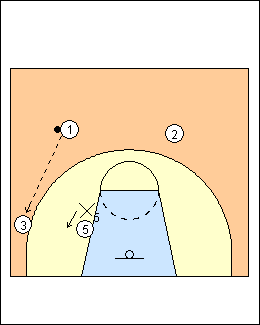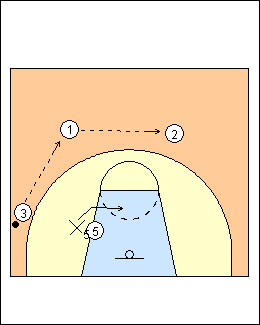4 on 1 post
 | 1 coachesclipboard.ca Post defender X5 should be in a top-side denial position when the ball is above the foul line, - positioned above the post attacker to prevent an easy duck-in or post entry from the top - ear-in-chest denial stance with his outside (right) hand extended into the passing lane (open to the ball), his inside (left) arm forms an arm bar parallel to the floor, in the attacker's chest or rib cage so there is space between the two players, making it easier for the defender to move around the post. To full-front the post when the ball is at the wing or below the foul line, - use two-step footwork, X5 steps with his outside (right) foot towards the ball, then steps with the inside (left) foot in front of the post towards the baseline - X5 releases the arm bar, dropping his inside hand down and tight to his body, then coming up in front of the post player (preventing a shoving match) - X5 has his chest facing the ball, hands high, sitting on the post's thighs, and calls "front". |
 | 2 When the ball is passed back to the top from the wing, there is a danger of getting reverse sealed. Taking away this pass can be done if there is ball pressure and the post defender is physical and forces the post lower on the floor. To go from full-fronting to top-side denial, X5 - forward pivots on his top (right) foot and follows the flight of the ball - drops his inside (right) arm into an arm-bar position and tries to push the post lower on the floor - extends his outside (left) hand into the passing lane - after preventing the direct pass, tries to re-gain the original top-side denial position (denying with the right not left hand). When the ball is passed to the weakside, X5 must jump to the ball and get proper ball-you-man spacing, but not get too open to the floor and allow an easy flash to the ball, he uses a 1/2-closed stance instead of a having his back to the baseline. Rick Torbett - Post Defense - on-the-line, up-the-line means both feet in the line of a pass (deny with your entire body) with an arm bar on his chest - the battle for space in the post is a foot battle, a hand in the passing lane isn't enough, beat his foot by stepping over his leg, hand and arm covering the passing lane. Lloyd Mitchell (Greenvale) - the general rule of their post defence is to always be closer to the line between the ball and the basket than the post attacker, or get into a full front position if he is on the line. When defending the mid or low post, half front in a denial stance when the ball is above the foul-line extended, step through and full front on a pass to the wing, if the ball goes back to the top, step through and regain a half-front denial stance. Defending the high post, half-front deny when the ball is on one side, move behind the post as the ball is reversed from one side to the other. Shane Dreiling - play on the high side of the post player if the ball is above the circle, play the low side if the ball goes below the circle, switch from high side to low using a simple spin move. Basketball Canada - a half or three-quarter front is usually used against low-post players. In a half-front, play beside the post, trying to get a hand in the passing lane and your back foot behind the post so you can reverse pivot to get rebounding position. A three-quarter front is full denial in front of and to the side of the post. When the ball is above the line of 45, play on the high side, when the ball is below the line of 45, play on the low side (although you can play on the top side when the ball is in the corner and the post is below the basket). You can change sides in a closed position (shuffle with your back to the ball) or open position (step across with the back foot, step through with the other foot). Back off once the post gets the ball, between the post and the basket. Lockdown Post Defence - a 3/4 front means one foot on top and in front, the other foot a little behind, almost even with the post's feet, with one hand in front and one hand on him (an arm bar). Bobby Knight - ball-side post defence - with the ball at the top, X5 has a hand between 5 and the ball (and in man or zone defence, there also has to be ballside help to prevent a direct pass into a good post, and to get in there if there is a direct pass, don't let him play one-on-one). On a pass to the wing, 5's first move is to seal X5, who should back off a bit, make 5 come into the lane, and get between 5 the basket, taking away baseline, knowing that 5 has only three seconds to be there. Jeff Lebo - he doesn't want the ball to go one pass then into the post, that's too easy, on a pass to 3, if 5 has a foot in the paint X5 gets around and fronts on the high side, he's in good shape if the ball goes back to the top (their rule is the ball can't be entered from the top). If the ball has moved around a couple of times they're not fronting, if 5 is outside the paint, X5 pushes him out with his lower body, right hand on the high side, encouraging a baseline pass, which gives them time to double-team from the top. Gord Herbert - with the FIBA lane, the post defender plays in a 3/4-front position when the ball is on the wing, then moves behind the post player on the flight of the ball, extends the inside arm into the passing lane to prevent an easy weakside pass, the other arm is an arm bar on the inside hip, baseline foot should be back so the attacker can't spin past, don't allow middle penetration, and force below the backboard if the post goes baseline. Tubby Smith - defend the post on the top side with the ball above the foul line, on a baseline drive it's almost a flash front, step on his leg, try to back him up, get on the baseline side, as the ball comes back out, if you can't get over top side (he's going to seal you), go behind. Bob Hurley - against a team with a star big, look for another big who is not involved in the offence, put your best post defender on him, he zones it up, fronts the star on a duck-in, the player who is not being guarded has to take some shots. If the opposing point guard doesn't offensive rebound, have your point guard help box out a post. Jeff Van Gundy - against a great post player, front by sitting on his front leg, pushing him back, don't be afraid of the lob pass, it's the most over-rated offensive play, rarely completed. On a lob, the closest defender comes with a mindset of steal (the pass) or seal (brace for a charge). Double from the elbow on a post catch, not off the passer, zone the rest of the floor, leave a post double on a shot, pass, or back dribble. A great post double is from the opposite baseline, the on-ball defender jumps high side (middle), the other big runs to the baseline side. Paul Henare - Post Offence and Defence - defending after a low-post catch, get low and square (feet square to the sideline), straddle his high leg (from behind), force baseline, baseline arm in the middle of his back, other hand kept high (most post players look middle with the ball), adjust as the post player moves. See Defending - Dick Bennett post defence, 1 on 1 post defence, Defence - Forcing left, also Post double-teams.  |
This page was made with Basketball playbook from Jes-Soft